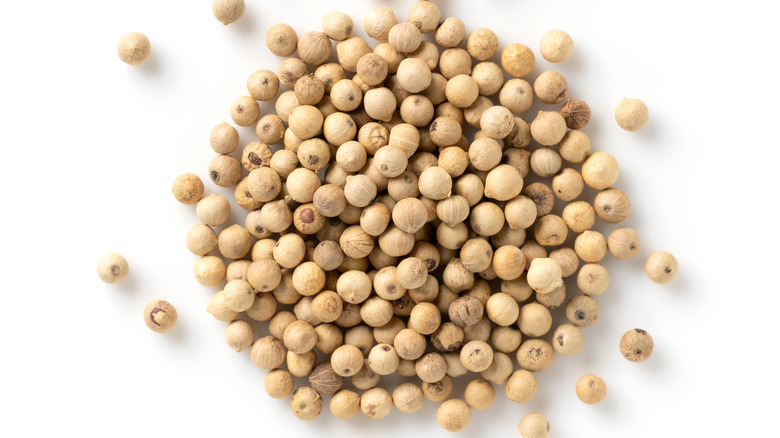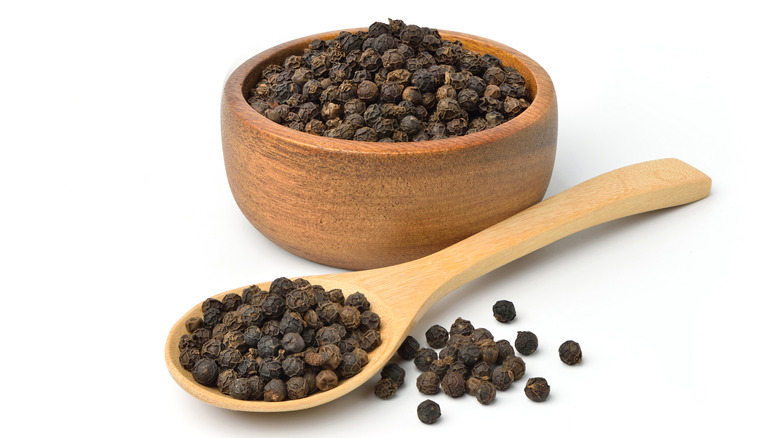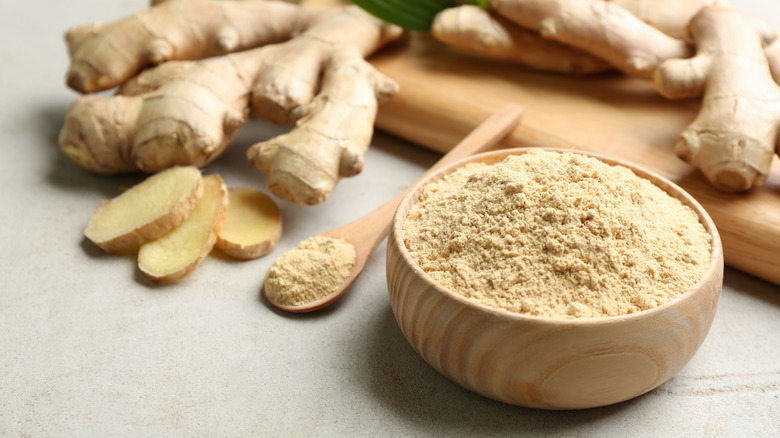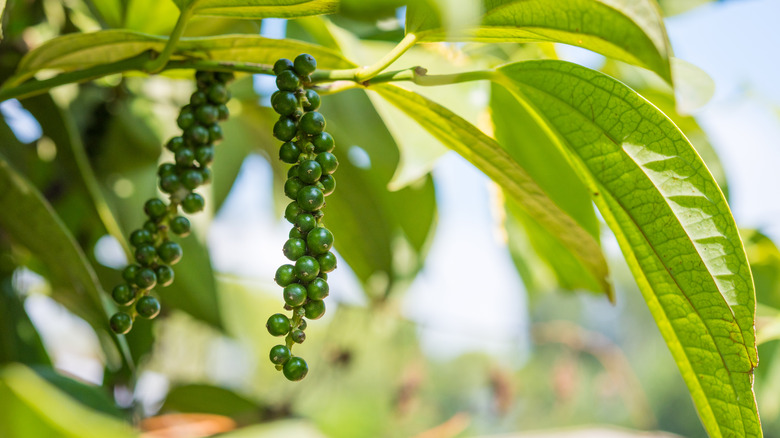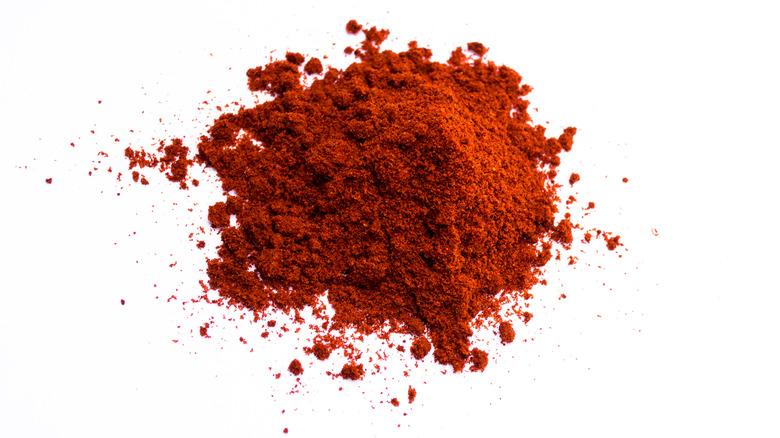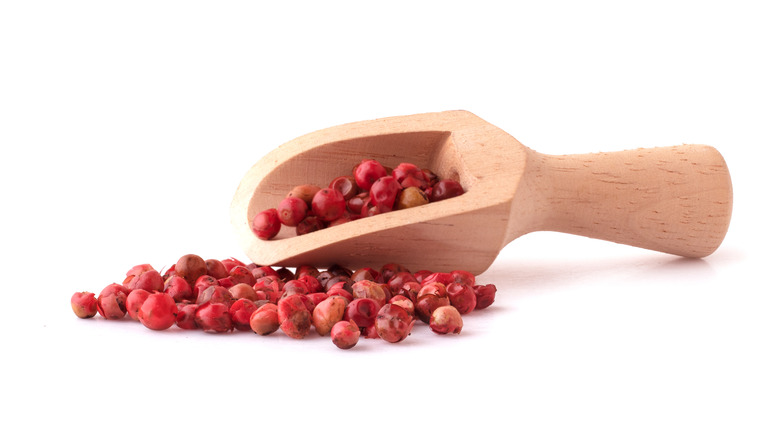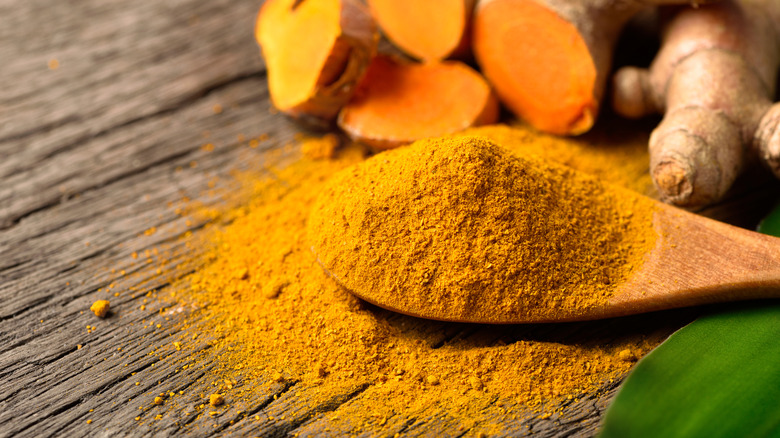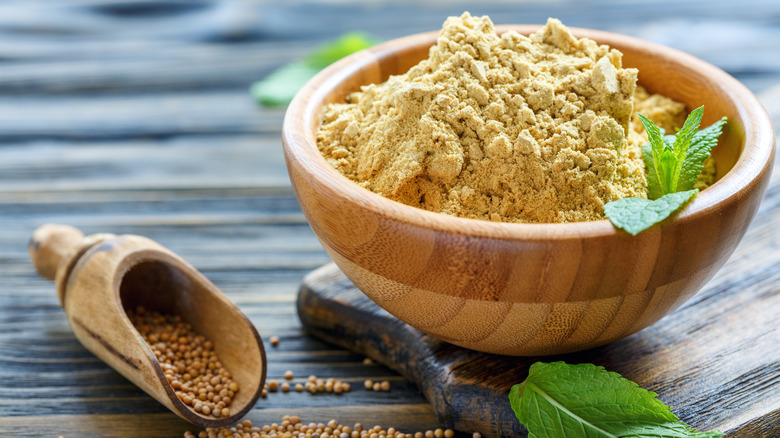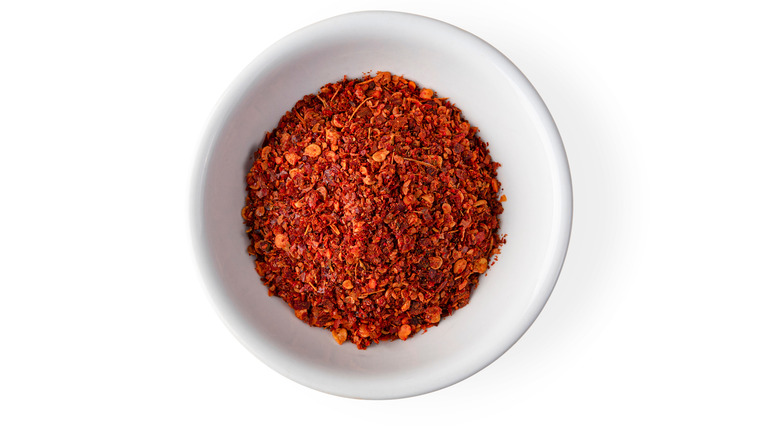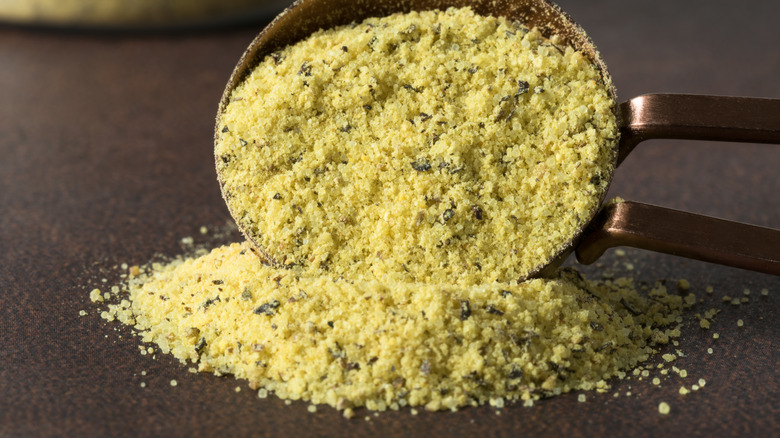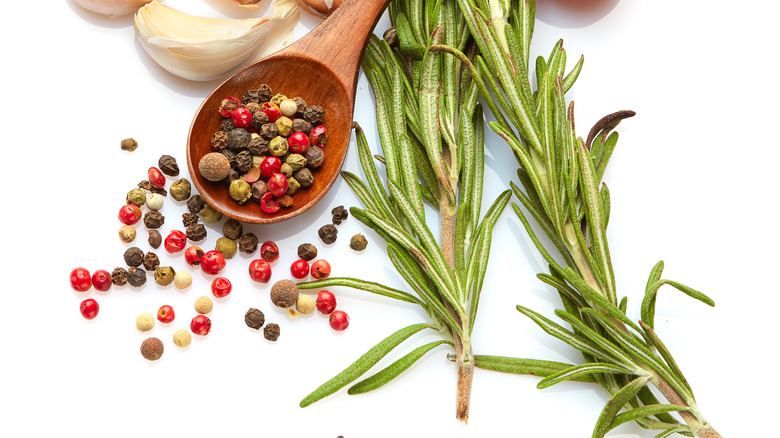10 Best Substitutes For White Pepper
One of the most useful resources in your kitchen is a well-stocked spice cabinet. Even simple dishes like a seared protein or roasted vegetables can be transformed with the addition of skillful seasoning, which makes your spices a key tool in your cooking arsenal. However, there's a good chance that at some point you'll find yourself either without a particular spice your recipe calls for, or having run out of that spice. You may be wrapped up in the cooking process and unwilling to run out to the store for just that one spice, especially since it's likely only required in small quantities. After all, will anyone really taste the difference if you swap out one teaspoon of a particular spice for another?
Salt and pepper are two of the most frequently used spices in most recipes, with a pinch of each acting as the seasoning baseline for the majority of dishes. However, white pepper has subtle differences from black pepper, which is often the default pepper variety called for in recipes. As Cook's Illustrated explains, white pepper is crafted from fully ripened white peppercorns that have their outer skin removed and that have been soaked in water. The process of making white pepper and the unique qualities of the peppercorn serve to temper the spicy heat of the pepper, instead adding earthy flavors and complexity.
If you happen to be out of white pepper, don't worry — here are 10 great substitutes that you may want to consider.
Black pepper
As you might have guessed, one of the best substitutes for white pepper is other types of pepper — after all, while there are subtle differences, they're still made from the same ingredient, so there are quite a few similarities in flavor. Black pepper is a great substitute for white pepper, and will give your dish that peppery kick. As a bonus, black pepper is a seasoning that even the most novice of cooks is likely to have on hand, since it's such a culinary staple, making it a very accessible swap.
The one downside with black pepper is the appearance. Typically, white pepper is used in dishes where you want that peppery kick, but you don't want little black pepper specks visible in your dish, like in chowders or cream sauces. So, you'll have to decide whether you can live with those speckles in your dish if you opt for this substitute.
Since black pepper does have a more powerful, aggressive flavor profile than white pepper, you'll want to be a little cautious with this one. For best results, halve the amount your recipe calls for — so if your dish requires a teaspoon of white pepper, swap in a half teaspoon of black pepper instead.
Ground ginger
Ground ginger is a versatile spice that adds great flavor to both sweet and savory dishes, making it a key addition to your spice cabinet — and also, as The Kitchen Community reports, a fantastic substitute for white pepper. This swap is particularly well-suited to Thai dishes, or other Asian cuisine, as those recipes already often call for ginger, so the flavor notes mesh seamlessly.
Like white pepper, ground ginger has a hint of heat and a slightly spicy yet earthy flavor profile with a lot of complexity. Also like white pepper, ground ginger is pale in color — typically a slightly toasted brown hue — that will blend into pale sauces without changing the color of your dish. As an added bonus, since this is a fairly common spice, you'll likely have it in your collection already.
For best results, you'll want to be a bit cautious and then adjust according to taste. So, if your recipe calls for a teaspoon of white pepper, add in a half teaspoon of ground ginger, taste, and then perhaps add another sprinkle if you feel the dish can take it. It's always easier to add a bit more of a spice than to take it away when it's already overpowered your dish. Also, note that this substitute is specifically ground ginger, not any grated or candied counterparts — those have a different flavor profile and much different impact on your dish in terms of both texture and intensity.
Green pepper
Since other colors of peppercorn make one of the closest substitutes for white pepper, you'll want to give green pepper a consideration when trying to figure out what to swap in your dish. Like pink peppercorns, you may have a slightly tougher time finding this particular color of peppercorn outside of a blend, but if you do happen to have some on hand, it's an ideal swap, according to Spiceography. You'll often find green peppercorns sold pickled, but the dried version that a powdered pepper is made from does exist.
One of the benefits of this swap is that green pepper is, like white pepper, fairly mild, so this substitute won't overpower your dish. The green hue is also less obvious in your pale-colored dish when added than black pepper (although it doesn't blend in quite as seamlessly as white or pink pepper will).
For best results with this substitute, you actually want to add a bit more than your recipe calls for, as the way green peppercorns are processed means the final product is a hint milder than white pepper. So, if your dish requires one teaspoon of white pepper, you'd want to add in a teaspoon and a half of green pepper instead.
Paprika
Another colorful spice that you likely have in your collection because of how versatile it is, paprika makes a great substitute for white pepper. While you can find sweet, smoked, and spicy variations, just the standard paprika works best for this particular swap, as you don't want to be adding too many other notes to the flavor profile of your recipe.
One of the main things to take into account with this substitute is obviously the hue — paprika is one of those spices that naturally colors the dish it's incorporated in when used in larger amounts. Depending on how much white pepper your recipe calls for, there's a good chance your final dish might end up taking on a slightly rosy hue if you swap paprika, which you may not want in certain dishes.
For best results, since paprika has a hint of heat and those color-changing properties, you may want to start out with half the amount and then adjust according to taste — thus, if your recipe requires one tablespoon of white pepper, add in half a tablespoon of paprika to start and potentially a pinch more once you taste the dish.
Pink pepper
If you're really looking for a mild pepper substitute, and fear that some stronger and more aggressive might over power the delicate flavor profile of your dish, you just might want to consider pink pepper, made from pink peppercorns. You might have spotted these stunning little globes in a colorful peppercorn mix, but they're also available to purchase just on their own.
Like white peppercorns, as The Kitchen Community explains, pink peppercorns are fermented and go through a process that tones down their flavor a bit. They may be a little tougher to find in all grocery stores, but there's still a fairly good chance you can either spot it on your next trip, or that you might even have some hanging around your pantry from when you went on a kick of grinding your own peppercorns. One benefit to this swap is that pink pepper is a very pale pink hue that blends effortlessly into most dishes the same way white pepper does, so you won't get those unattractive specks you'd find with black pepper.
For best results, since pink pepper is mild in the same way white pepper is, you can do a direct swap — so in place of one teaspoon of white pepper, you'd sprinkle in a teaspoon of pink pepper.
Turmeric
Turmeric is such a distinct spice that you may have not considered swapping it in for something relatively mild, like white pepper — however, it actually makes a great substitute for white pepper.
As any fans of the colorful seasoning will know, turmeric has earthy flavor notes with a hint of warmth and bitterness, and the unique flavor profile accentuates many dishes. This swap works particularly well with Thai cuisine and dishes such as curry, so if you're whipping up a dish in that culinary family, you may want to consider this swap. The one thing to be aware of when using turmeric is the color — as Food52 reports, the colorful spice will stain "just about anything," including the overall hue of your dish. So, just be mindful of the fact that this won't blend in the way white pepper, and will definitely give your dish a sunny hue.
For best results, you can do a direct swap, using a teaspoon of turmeric powder in place of a teaspoon of white pepper, for example.
Mustard powder
Mustard packs a ton of flavor and can be a great addition to anything from sauces to salad dressings — and if you don't have mustard powder (ground mustard) in your spice collection yet, it's something you should consider, even if you always have a few different bottles of mustard on hand. It's a great addition to a well-stocked pantry, and makes a good substitute for white pepper.
Mustard powder has an intriguing flavor that also delivers a healthy dose of spice without being too fiery, which makes it a great complement to many different flavors. This is also quite a readily available spice, so the chances of you having it in your collection already are decent. The one downside to this swap is that, while it doesn't have as strong a hue as some other spices, it may potentially give your dish a slightly yellow tint if you're crafting a pale chowder or sauce, which you might not want.
For best results, since mustard powder does have quite a pungent flavor, you'll want to be a bit conservative with this swap — if your recipe calls for a teaspoon of white pepper, add in about half a teaspoon of mustard powder (or a pinch, as some recipes may say) and then adjust if you think the dish needs a tad more
Cayenne Pepper
If you love spicy foods, there's a good chance you have cayenne pepper in your spice collection, and it actually works as a good substitute for white pepper. It adds some serious heat to the final dish, which in some recipes, might be a welcome change (or may simply require dialing back on some other spicy seasonings, if the dish you're using the substitute in is already spicy). There are just two things to take note of. First, cayenne's flavor profile leans overwhelmingly in the direction of heat — so, it'll add that spice to your dish, but won't really bring in any of the other earthy, more delicate flavor notes that white pepper does. Second, while it's not quite as colorful as spices such as turmeric and paprika, it does have the potential to give your dish a slightly red hue.
Cayenne pepper is a powerful spice, so for best results, you want to use it very sparingly — if your recipe calls for a teaspoon of white pepper, for example, swap in a mere ⅛ teaspoon of cayenne to avoid overpowering your dish.
Lemon Pepper Mix
If you have a relatively robust spice cabinet, you likely have a few bottles of mixed spice blends on hand for when you want to add a burst of flavor to a recipe without digging out seven different spice bottles. Lemon pepper seasoning blends are very common, and they work as a good substitute for white pepper in a variety of dishes.
The positive of this swap is that lemon is an ingredient that complements so many different flavors, adding that burst of freshness and brightness, so you can use this substitute for many different recipes. However, you will want to be mindful of what exactly is in the spice blend — take a quick scan of the ingredients list and consider dialing back on a few other seasonings if they're also present in the lemon pepper blend. After all, if you're already shaking in a burst of onion and garlic powder, you may not want to add extra of those seasonings, for example.
For best results, since the blend incorporates a variety of spices and thus doesn't become as overpowering quite as quickly as single spices, you can do a direct swap — so if your recipe calls for a teaspoon of white pepper, you'd add a teaspoon of lemon pepper mix in its place.
Garlic Pepper Mix
Flavored pepper mixes such as garlic pepper make a great swap for white pepper, bringing an extra burst of "color and joy" to your recipe. While there are plenty of mixes on the market, garlic pepper is a solid one because, well, garlic goes with just about everything — whatever your recipe, there's a good chance it already called for a sprinkle of garlic powder or a minced clove or two of the pungent ingredient, so this swap shouldn't change the overall flavor profile of your dish.
Garlic pepper blends are also quite commonly available because of what a classic seasoning garlic is, so there's a good chance you may already have this one in your pantry or spice collection. The one thing to be mindful of, as with any blend, is the particular spices in your mix — if your garlic pepper blend already contains salt and onion powder, for example, you may want to skip adding those entirely, or taste and determine whether your recipe still needs them.
For best results, you can generally do a direct substitution — so if your recipe calls for a teaspoon of white pepper, add in a teaspoon of garlic pepper mix instead.
